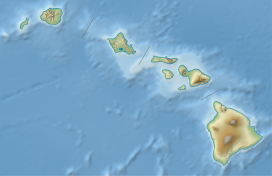| West Maui Volcano | |
|---|---|
| Mauna Kahālāwai | |
 Lihau (center) and Helu (right) peaks | |
| Highest point | |
| Elevation | 5,788 ft (1,764 m)[1] |
| Prominence | 5,668 ft (1,728 m)[1] |
| Coordinates | 20°53′37″N 156°35′22″W / 20.89361°N 156.58944°W |
| Geography | |
| Parent range | Hawaiian Islands |
| Topo map | USGS Kilohana (HI) |
| Geology | |
| Rock age | 1.32 Mega-annum |
| Mountain type | Much eroded shield volcano |
| Volcanic arc/belt | Hawaiian-Emperor seamount chain |
| Last eruption | <320,000 years |
The West Maui Mountains, West Maui Volcano, or Mauna Kahālāwai[2] (which means "holding house of water")[3] are the remnants of an eroded shield volcano that constitutes the western quarter of Maui. Approximately 1.7 million years old,[4] the volcano's last eruption was approximately 320,000 years ago. Thanks to hundreds of inches of rainfall annually the mountains have undergone substantial stream erosion.[5] The ʻĪao Valley, and it's Iao Needle are popular attractions within mountains, is accessible from Wailuku.
The three districts (moku) of West Maui are Lahaina, Kāʻanapali, and Wailuku.[6] Wailuku is also known as "Pūʻalikomohana" ("west isthmus"), or "Nā Wai ʻEhā" ("the four waters"). The port of Lahaina lies on the southwestern slope.
The summit peak at 5,788 ft (1,764 m) elevation is called "Puʻu Kukui," which translates to "candlenut hill".[7]
- ^ a b "Puu Kukui, Hawaii". Peakbagger.com. Retrieved 10 August 2014.
- ^ "Keawala'i Congregational Church, Kahu's Mana'o". www.keawalai.org. Retrieved 2019-01-24.
- ^ "Hawaii". Elope Maui. Retrieved 2019-01-24.
- ^ Basic Manual for Hawai'i's Tour Drivers/Guides v-6
- ^ Cite error: The named reference
Sintonwas invoked but never defined (see the help page). - ^ "Native Hawaiian Land Division". Haleakalā National Park. U.S. National Park Service.
- ^ Pukui, Mary Kawena; Elbert, Samuel H.; Mookini, Esther T. (1974). Place Names of Hawaii. University of Hawaii. p. 200.
